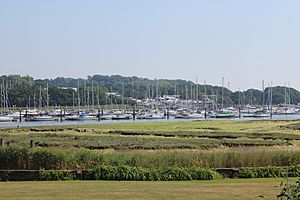Hackett's Marsh facts for kids
Quick facts for kids Hackett's Marsh |
|
|---|---|
 |
|
| Type | Local Nature Reserve |
| Location | Bursledon, Hampshire |
| OS grid | SU 488 089 |
| Area | 20.4 hectares (50 acres) |
| Managed by | Hampshire Countryside Service |
Hackett's Marsh is a special place in Bursledon, Hampshire, covering about 20.4 hectares (which is like 50 football fields!). It's known as a Local Nature Reserve, which means it's protected because of its important wildlife and natural features. Hampshire County Council owns this land, and the Hampshire Countryside Service helps look after it.
This marsh is also part of some even bigger protected areas. It's included in the Solent and Southampton Water Ramsar site (a special wetland area) and a Special Protection Area for birds. It's also part of the Solent Maritime Special Area of Conservation and the Lincegrove and Hackett's Marshes Site of Special Scientific Interest. These names might sound long, but they all mean Hackett's Marsh is a really important spot for nature!
Contents
What is a Local Nature Reserve?
A Local Nature Reserve, or LNR, is a place that's important for nature and is also a great spot for people to visit and learn. They are often close to towns and cities, making it easy for local communities to enjoy them. LNRs help protect wildlife and habitats, and they also give people a chance to connect with nature.
Habitats at Hackett's Marsh
Hackett's Marsh has two main types of habitats:
- Saltmarshes: These are coastal wetlands that are flooded by salty water when the tide comes in. They are very important because they act like natural sponges, soaking up water and protecting the land from floods. They also provide a safe home for many plants and animals that can handle salty conditions.
- Species-rich Grassland: This is an area of grassland that has many different types of plants growing in it. The variety of plants means there's a good food source and shelter for lots of different insects and small animals.
Amazing Wildlife
Hackett's Marsh is buzzing with life! It's especially known for its many different kinds of insects. Some of these insects are quite rare and hard to find anywhere else in the country.
These insects are super important because they provide food for many birds, especially wading birds. You might spot some of these birds looking for food in the marsh:
- Golden Plovers: These are medium-sized birds with beautiful golden-brown feathers.
- Black-tailed godwits: These birds have long legs and a long beak, perfect for poking around in the mud for food.
- Curlews: You can recognize curlews by their very long, curved beaks and their distinctive "cur-lew" call.
These birds travel long distances, and Hackett's Marsh offers them a vital place to rest and feed during their journeys.
Why is Hackett's Marsh Protected?
Hackett's Marsh is protected for several important reasons:
- Protecting Rare Species: It provides a home for rare insects and other wildlife that might struggle to survive elsewhere.
- Important Habitats: The saltmarshes and grasslands are valuable habitats that support a wide range of plants and animals.
- Bird Sanctuary: It's a crucial feeding and resting spot for many wading birds, especially during migration.
- Natural Flood Defense: The saltmarshes help protect the nearby land from coastal flooding.
- Education and Enjoyment: As a Local Nature Reserve, it allows people to learn about and enjoy nature in a safe environment.
By protecting places like Hackett's Marsh, we help ensure that these special natural areas and the amazing creatures that live there can thrive for many years to come.

